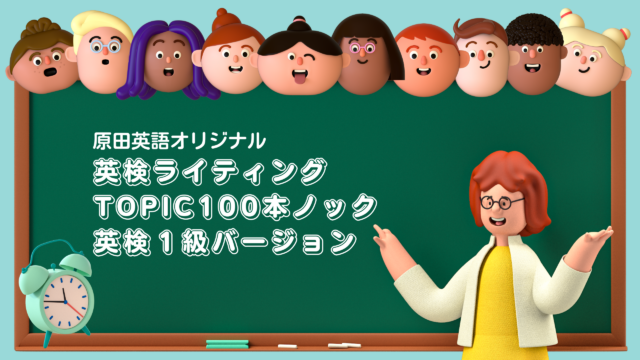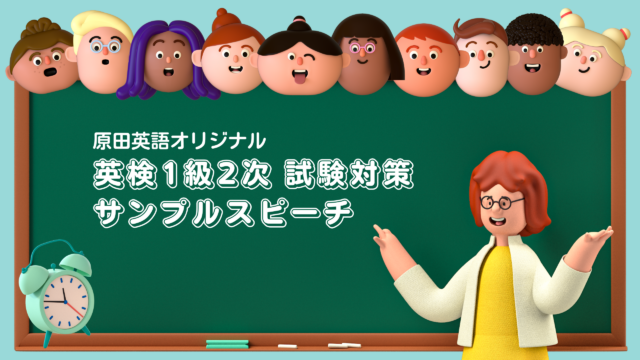英検1級の要約問題の解き方!
英検のウェブサイトに掲載されている安河内哲也先生のYouTube動画が役に立ちます。動画を要約すると、要約問題の5つの手順として
1️⃣ 主張の特定:論文全体を読み、筆者の主張を見つけ出し、それを中心に要約を組み立てる。
2️⃣ 具体的な用語の抽象化:具体的な用語や固有名詞を一般的な表現に置き換える。例:‘~湖、~川’ ➡️ ‘水源’
3️⃣ 論理性の構築:因果関係を考慮し、本文と同じ論理的な構造を保つ。
4️⃣ 冗長部分の排除:冗長な情報や繰り返しを削除し、本質的な情報に焦点を当てる。
5️⃣ 完結性の確認:要約文だけを読んでも、筆者の主張が伝わるか確認する。
以上が鉄板です!また、要約問題の対策として
📚 日常の学習:パラフレーズの力を磨き、論理的な読解習慣を身につけ、アカデミックな英語に触れ、4技能を融合的に学ぶ。
ことが大切と力説しています。
ではさっそく、英検1級のサンプル予想問題を生成AIで作成するためのプロンプトをご紹介しましょう!まずはプロンプトをもとに作成した問題と模範解答をご覧ください!
【Summary Question】
● Instructions: Read the article below and summarize it in your own words as far as possible in English.
● Suggested length: 90-110 words
● Write your summary in the space provided on your answer sheet. Any writing outside the space will not be graded.
The digital revolution has significantly transformed the landscape of education, shifting the traditional classroom-based learning to a more dynamic, digital environment. This evolution has enabled access to educational resources on a global scale, making learning opportunities more accessible and flexible than ever before. Through digital platforms, such as Massive Open Online Courses (MOOCs), virtual laboratories, and interactive simulations, learners can engage with materials that cater to their individual needs and preferences, enhancing the personalization of education. These technologies facilitate a more interactive and engaging learning experience, promoting higher levels of participation and retention among students.
However, the shift towards digital education is not without its challenges. One of the most pressing issues is the digital divide, which refers to the gap between individuals who have access to modern information and communication technology and those who do not. This divide can exacerbate existing inequalities, as students in underprivileged areas may lack the necessary resources and connectivity to fully participate in digital learning environments. Additionally, concerns over data privacy and the impact of increased screen time on physical and psychological health are growing. These challenges highlight the need for a balanced approach to integrating technology into educational systems, ensuring that it serves to enhance rather than detract from the learning experience.
In response to these developments, the role of educators has evolved from traditional teaching methods to more of a facilitative role, guiding students through the vast array of digital resources and fostering a learning environment that encourages critical thinking and digital literacy. This transition demands ongoing professional development and a willingness to adapt to new teaching strategies. As the education sector continues to navigate the complexities of the digital age, the challenge lies in leveraging the potential of technology to enrich educational outcomes while addressing the associated challenges to ensure an inclusive, equitable, and effective learning environment for all students.
【Model Answer】
The transformation brought by digital technology has reshaped education, facilitating access to tailored learning experiences through online platforms, making knowledge more universally accessible. Nonetheless, this shift introduces challenges, such as disparities in technological access that deepen educational inequalities, and raises concerns regarding privacy and the potential negative effects of extensive screen exposure. As a result, the role of educators has shifted towards facilitating access to digital resources, requiring continuous adaptation and professional growth. The pivotal challenge for the education sector is to harmonize the advantages of digital advancements with these concerns, aiming to create an inclusive, equitable, and effective educational framework for all learners.
こんな形で英検1級形式のサンプル予想問題が作成されます。語数も英検の公式サイトに掲載されているサンプル問題とほぼ同じ309語(英検サンプルは310語)で、模範解答も104語となっています。では、実際のプロンプトをご紹介しましょう!!
あなたは英検1級の要約問題作成のプロフェッショナルです。以下の【要約問題の例】と【解答】を参考に、
★同じ分量の英文(310 words前後)
★同じレベルの英文(CEFRのB1レベル以上)
★アカデミックな英文
★要約問題は必ず3パラグラフ構成からなる310語前後の英文を作成する
★抽象的な表現や固有名詞を多く使用する
以上に従って要約問題を作成してください。ただし、要約問題のトピックは
・教育・生活・環境、社会・ビジネス、IT、メディア・日本と世界・政治など、バラエティーに富んだものにしてください。
次に、その解答として
★CEFRレベルC1(B1以上)の語彙レベルを使用
★90語~110語で要約
★具体的な英語表現を抽象化して作成
★転換語(First、Next、in conclusion、in response)や however、Althoughなどの接続詞を効果的に使う。
● Instructions: Read the article below and summarize it in your own words as far as possible in English.
● Suggested length: 90-110 words
● Write your summary in the space provided on your answer sheet. Any writing outside the space will not be graded.
以上の点に注意し解答を作成してください。
【要約問題の例】
Poyang Lake is China’s biggest freshwater lake. Although people have fished it for generations, these days, a new resource is being removed—sand. Up to 10,000 tons of sand are dug up from the lake floor per hour, making this the world’s largest sand mine. Much of the sand is shipped to Shanghai—a city whose population has risen by 7 million since 2007—where it is used in the construction of high-rises, roads, and other structures. Massive mining operations exist not only in China but also in other nations, including Australia and the United States. Globally, the largest importer of sand is Singapore, which has used
the resource to increase its territorial landmass by 20 square miles.
The consequences of sand mining are a major concern. Removing sand from water bodies increases water sediment, blocking out sunlight; this interferes with underwater plants’ production of oxygen, making survival for fish and other organisms difficult. In the case of Poyang Lake, sand removal has made the channels leading out of the lake much deeper and wider, doubling the amount of water flowing outward. Consequently, the lake’s water level has dropped dramatically. This threatens the water supply to neighboring wetlands, which are home to numerous bird species and other wildlife.
Many countries are becoming increasingly aware of the damage caused by sand mining. Demand for the resource has taken a toll on Indonesia, Malaysia, and Cambodia, which have banned sand exports in efforts to preserve local ecosystems. However, increasing demand means that when mining stops in one area, other areas take on the burden of supply. China’s Yangtze River, for example, was formerly a major sand-mining site, but by the late 1990s so much had been removed that bridges collapsed along with large sections of the riverbank. When sand mining was banned on the Yangtze in 2000, operations shifted to Poyang Lake.
【解答】
Sand is being mined in large quantities from bodies of water around the world to fuel the development of urban areas. Despite the various positive effects that may result from these activities, sand mining also has ecological consequences that endanger the lives of various organisms. In response, some governments are trying to mitigate the harm that arises from this by enacting laws that prohibit the export of sand. Unfortunately, banning sand mining appears to only be a temporary solution in some locations as mining operations often end up simply moving to other sites.
以上がプロンプトです。生成する過程では、問題文、解答文の文字数が指定語数と大きく異なる場合もよくあるのですが、その際は、たとえば
「解答文の語数が指定語数の90-110語ではありません。書き直してください」
と書けば
「すいません、再度作成します」
と礼儀正しく書き直してくれます^^;それでも語数が合わない場合は、根気強く「まだ足りません」とか「多すぎます」などと教えてあげてください!また、解答の単語が余りにも難しい場合は、「単語をB1レベルにして」などと命令すればチェンジしてくれます。
もちろん、この方法で作成する英検1級の要約問題は、実際の問題や解答と異なるかもしれません。しかし、題材が何もなく、何をすれば良いのか分からないのであれば、とても価値のあるサンプル問題として役立つこと間違いなしです!









